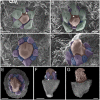Floral ontogeny of Tachigali (Caesalpinioideae, Fabaceae) species
- PMID: 36101879
- PMCID: PMC9464433
- DOI: 10.7717/peerj.13975
Floral ontogeny of Tachigali (Caesalpinioideae, Fabaceae) species
Abstract
Background: The present ontogenetic study reveals variations throughout floral development in three morphologically representative species from the genus Tachigali, allowing a better understanding of floral organs diversity, flower symmetry and their homologies, especially in Fabaceae, a diverse family that exhibits a wide variation in floral architecture. Tachigali (Caesalpinioideae) corresponds to an important Neotropical legumes tree genus with 58 species in Brazil. Species of the genus Sclerolobium Vogel were incorporated in its circumscription, increasing the diversity of its floral morphology.
Methods: This work aims to perform an ontogenetic study of T. denudata, T. paratyensis and T. spathulipetala, morphologically representative species of Tachigali, in order to describe the floral development and to better comprehend the floral morphology varieties among the species, using scanning electron microscopy.
Results: We found the studied species to have floral buds with acropetal and helical development along the inflorescence axis; sepals and petals with helical development, varying the position of the primordia in the bud, according to the different species; stamens with unilateral development and carpel with adaxial curvature. These data correspond to original records of Tachigali ontogeny and contribute to an improved understanding of floral morphology and symmetry with data related to the zygomorphic and early development of the sepals and petals.
Keywords: Floral development; Floral symmetry; Sclerolobium.
© 2022 Marques Casanova et al.
Conflict of interest statement
The authors declare that they have no competing interests.
Figures





References
-
- Barreta-Kuipers T. Wood anatomy of Fabaceae: its relevance to taxonomy. Part 2. In: Polhill RM, Raven PH, editors. Advances Legume Systematics. Kew: Royal Botanic Gardens; 1981. pp. 677–706.
-
- Barros TC, Pedersoli GD, Paulino JV, Teixeira SP. In the interface of caesalpinioids and mimosoids: comparative floral development elucidates shared characters in Dimorphandra mollis and Pentaclethra macroloba (Leguminosae) American Journal of Botany. 2017;104:218–232. doi: 10.3732/ajb.1600308. - DOI - PubMed
-
- Bozzola JJ, Russel LD. Electron microscopy. Toronto: Jones and Barlett Publisher Canada; 1999.
-
- Bruneau A, Klitgaard BB, Prenner G, Fougère-Danezan M, Tucker SC. Floral evolution in the Detarieae (Leguminosae): phylogenetic evidence for labile floral development in an early-branching legume lineage. International Journal of Plant Sciences. 2014;175:393–417. doi: 10.1086/675574. - DOI
-
- Casanova JM, Cardoso D, Barros CF, Lima HC, De Toni KLG. Floral morphology and development in Tachigali (Caesalpinioideae, Leguminosae), a predominantly rainforest tree genus with contrasting flower architectures. Plant Systematic and Evolution. 2020;306:1–13. doi: 10.1007/s00606-020-01642-2. - DOI
Publication types
MeSH terms
LinkOut - more resources
Full Text Sources

